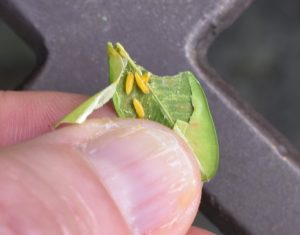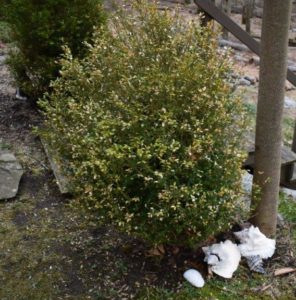Hello Fellow Readers, I think you’ll enjoy this story about Boxwood Leaf Miner also known as Hotdog Flies :^)
“Our boxwoods are hissing,” my new neighbor said. Monica and her husband are first-time homeowners filled with do-it-your self-skills and stamina. “I searched online and found out they’re Hotdog Flies,” she added.
I never knew Boxwood Leaf Miner’s “sing”
As it turns out, the noisy feeders are Boxwood Leaf Miner (Monarthropalpus flavus), sadly a widespread pest killing boxwoods. I never knew they sang a chorus, though. Others describe it as a fizzing, crackling, or popping noise.
The larvae overwinter in the leaves. Once Spring arrives, they feed. Then, the adults emerge, typically the end of April or early May here. They look like little orange mosquitoes that linger on the leaves for a day or two before flying off. They don’t fly far, sticking around to mate before inserting their eggs in the underside of the boxwood leaves for the next generation. If left untreated, these stealth intruders will ultimately kill the plant.
Monica described the “gross little orange worms” living inside the leaves and declared they are getting rid of the shrubs.
Before good riddance, I went to see the scope of their dilemma. Most leaf miners, on spinach or columbine, for example, travel inside a leaf and leave a trail visible from the outside. Not so with these mini hotdog looking thingies. Instead, the cause blistering on the undersides of leaves, followed by yellowing or browned splotches and defoliation.
Protocols to control Boxwood Leaf Miner
While Monica’s boxwoods were too far gone to save, there are ways to control an early infestation. Prune the infected foliage before the flies emerge to help control the population. Then spray a safe insecticide when the new leaves are fully formed in early May and again in mid-June to July. Neem oil is my go-to natural alternative extracted from the Neem tree (Azadirachta indica) native to India. It has both antibacterial and antiseptic attributes that discourage both fungi and parasites. Spinosad, such as Bull’s Eye, is another option. Both are safe for people, pets, and the environment.
Like any plant, maintaining health helps prevent pests and diseases. Many make the mistake of adding acidic fertilizer around boxwood, assuming they need an acid boost like rhododendron and azalea. Boxwood prefers neutral to slightly alkaline soil pH of 6.8 to 7.5.
With my Hotdog Fly knowledge in full gear, I visited a client whose boxwood showed signs of the same invader. Opening a leaf exposed the wiggly orange leaf miner larvae. Julie’s garden has landscape fabric, a no-no as it inhibits nutrition absorbing into the soil. Besides, ultimately the mulch on top breaks down, allowing weeds to grow.
Julie’s garden has black mulch, another negative to plant health. Dyed mulch is often made from recycled lumber filled with chemicals. Never mind the chemicals in the dye itself that can affect plant health. Then there’s the heat factor. Much like blacktop, black mulch absorbs heat, which is stressful to plants. Instead, go fabric-free and use a natural mulch like aged hemlock to keep hotdogs on a bun and off your boxwood.
Garden Dilemmas? AskMaryStone@gmail.com (and now on your favorite Podcast App.)
There are resistant cultivars of English boxwood such as Buxus sempervirens ‘Suffruticosa,’ ‘Pendula,’ ‘Pyramidalis,’ ‘Argenteo-Variegata,’ ‘Handworthiensis,’ and ‘Varder Valley.’ And they say Japanese Boxwood (B. microphylla var. japonica) are more resistant to leaf miner as well.
Click through to another dilemma of boxwood is Boxwood Blight Coming to Town?
More about Neem Oil
Link to the American Boxwood Society





Goodbye creepy skin crawling hissing!! Thank you for all your advice!
You’re welcome, Monica. Thank you for sharing your hissing boxwood dilemma. I had never known boxwood leaf miner made such a noise! Good riddance :^), Mary
Mary Stone, Thanks for your advice.